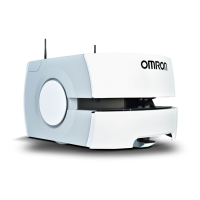102 LD-60/90 Platform User's Manual 11970-000 Rev M
7.1 Operating Environment
Obstacles
If the AMR will be entering high-traffic areas, take appropriate precautions to alert people in
those areas that an AMR might enter. If the traffic consists of other machines, adjust the
AMR’s and/or the other machine’s parameters to reduce the risk of a collision.
Take care to avoid:
l glass doors and walls
l pits without railings or low bumpers
l floors with access panels removed
l loose cables, hoses, etc.
l large, highly-reflective objects
Environment and Floor
Environmental Limits
The following environmental limits apply.
Characteristic Operating Limits
Temperature 5 to 40°C
Humidity 5% to 95%, non-condensing
Altitude Up to 1000 m above mean sea level
Atmospheric
WARNING: Do not use the AMR in hazardous
environments (explosive gas and oil mist).
Radiation Do not use the AMR in the presence of ionizing or non-ionizing
radiation.
Floor Characteristics
Floors must provide good traction, typical of good walking conditions. The following specified
limits assume that the AMR's wheels are in good operating condition.
l
Flatness and Texture
Driving on rough or uneven floors can affect traction and navigation and also reduce
the life of drive train components. Safety might be affected because the laser's sensing
plane is not always parallel to the floor.
Even on smooth, level floors, dust, dirt, grease, and water (or other liquids) can affect
traction. If the drive wheels slip it can potentially affect operating duration and nav-
igation accuracy.
Use a slip meter (such as the Reagan Scientific BOT-3000e) to measure the floor’s coef-
ficient of friction. The slip meter must:

